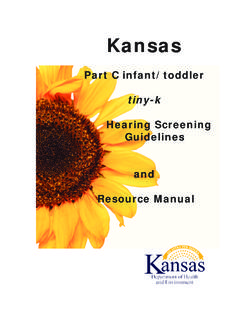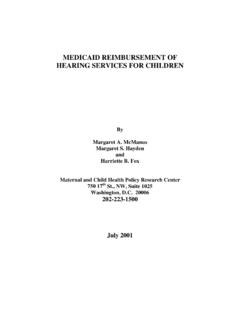Transcription of Hearing Screening Coding Fact Sheet for Primary Care ...
1 Hearing Screening Coding fact Sheet for Primary Care Pediatricians While Coding for Hearing Screening is relatively straightforward, ensuring that appropriate payment is received for such services is a more complicated matter. This Coding fact Sheet will provide you with a guide to Coding for pediatric Hearing Screening . While we have provided you with some suggested codes, it should be noted that payer recognition of codes might vary. Strategies and a template letter for pediatric practices to handle payer denials and contractual issues are provided in Denial Management and Contract Negotiation for Hearing Screening Services . (Appendix A).
2 Diagnosis Codes International Classification of Diseases, Ninth Revision, Clinical Modification (ICD-9-CM) Codes Commonly Reported Diagnosis Codes Related To Primary Care Pediatricians & Hearing Loss Conductive Hearing loss, unspecified Sensorineural Hearing loss, unspecified Sensorineural Hearing loss, bilateral Neural Hearing loss, bilateral Central Hearing loss, bilateral Sensorineural Hearing loss, unilateral Sensorineural Hearing loss, asymmetrical Sensorineural Hearing loss of combined types, bilateral Mixed conductive and sensorineural Hearing loss Unspecified Hearing loss Other Diagnosis Codes Related To Hearing Loss Nervous System and Sense Organs Infective otitis externa.
3 Unspecified Acute swimmers' ear Impacted cerumen Chronic serous otitis media, simple or unspecified Nonsuppurative otitis media, not specified as acute or chronic Dysfunction of Eustachian tube Acute suppurative otitis media without spontaneous rupture of ear drum Acute suppurative otitis media with spontaneous rupture of ear drum Unspecified chronic suppurative otitis media Bullous myringitis Perforation tympanic membrane, unspecified Labryinthitis, unspecified Tinnitus Otorrhea, unspecified Otalgia, unspecified Congenital Anomalies Unspecified anomaly of the ear Injury and Poisoning Open wound of ear; ear drum 931 Foreign body in ear Motion sickness Symptoms, Signs, and Ill-Defined Conditions Dizziness and giddiness (vertigo NOS).
4 Voice disturbance, unspecified Voice disturbance; other (change in voice/dysphonia/hoarseness/hypernasality /hyponasality). Other speech disturbance (dysarthria/dysphasia/slurred speech). Other abnormal clinical findings Abnormal findings on neonatal Screening Other NOTE: The ICD-9-CM codes below are used to deal with occasions when circumstances other than a disease or injury are recorded as diagnoses or problems. Some carriers may request supporting documentation for the reporting of V codes. Personal history of unspecified disorder of nervous system and sense organs Personal history of infections of the central nervous system Personal history of other disorders of nervous system and sense organs Problems with Hearing Other ear problems Other postprocedural status Other specified health conditions influencing health status Long-term (current) use of other medications Other psychological or physical stress not elsewhere classified.
5 Other Unspecified psychosocial circumstance Other person consulting on behalf of another person Other specified counseling Encounter for Hearing examination following failed Hearing Screening Other examination of ears and Hearing Procedure Codes Current Procedural Terminology (CPT ) Codes Commonly Reported Procedure Codes Related To Primary Care Pediatricians & Hearing Loss 92551 Screening test, pure tone, air only 92552 Pure tone audiometry (threshold); air only 92567 Tympanometry (impedance testing). 69200 Removal of foreign body from external auditory canal; without general anesthesia 69210 Removal impacted cerumen (separate procedure); one or both ears 69420 Myringotomy including aspiration and/or eustachian tube inflation 92587 Evoked otoacoustic emissions; limited (single stimulus level, either transient or distortion products).
6 Health and Behavior Assessment/Intervention Codes These codes cannot be reported by a physician nor can they be reported on the same day as Preventive Medicine Counseling codes (99401-99412). 96150 Health and behavior assessment (eg, health-focused clinical interview, behavioral observations, psychophysiological monitoring, health-oriented questionnaires), each 15 minutes face-to-face with the patient; initial assessment 96151 Health and behavior assessment (eg, health-focused clinical interview, behavioral observations, psychophysiological monitoring, health-oriented questionnaires), each 15 minutes face-to-face with the patient; re-assessment The focus of the assessment is not on mental health but on the biopsychosocial factors important to physical health problems and treatments.
7 96152 Health and behavior intervention, each 15 minutes, face-to-face; individual 96153 Health and behavior intervention, each 15 minutes, face-to-face; group (2 or more patients). 96154 Health and behavior intervention, each 15 minutes, face-to-face; family (with patient present). 96155 Health and behavior intervention, each 15 minutes, face-to-face; family (without patient present). The focus of the intervention is to improve the patient's health and well-being utilizing cognitive, behavioral, social, and/or psychophysiological procedures designed to ameliorate the specific Hearing -related problems. Healthcare Common Procedural Coding System (HCPCS) Level II Procedure and Supply Codes CPT codes are also known as Healthcare Common Procedure Coding System (HCPCS) Level I codes.
8 The Healthcare Common Procedure Coding System also contains Level II codes. These Level II codes (commonly referred to as HCPCS hick-picks codes) are national codes that are included as part of the Health Insurance Portability and Accountability Act of 1996 (HIPAA) standard procedural transaction Coding set along with CPT codes. HCPCS Level II codes were developed to fill in the gaps in the CPT nomenclature. While they are reported in the same way as a CPT code, they consist of one alphabetic character (A-V) followed by four digits. In the past, insurance carriers did not uniformly recognize HCPCS Level II codes. However, with the advent of HIPAA, carrier software systems must now be able to recognize all HCPCS Level I (CPT) and Level II codes.
9 HCPCS Hearing Services Codes S9445 Patient education, not otherwise classified, nonphysician provider, individual, per session S9446 Patient education, not otherwise classified, nonphysician provider, group, per session T1023 Screening to determine the appropriateness of consideration of an individual for participation in specified program, project, or treatment protocol, per encounter T1027 Family training and counseling for child development, per 15 minutes T1028 Assessment of home, physical, and family environment, to determine suitability to meet patient's medical needs T2022 Case management, per month T2023 Targeted case management, per month T2024 Service assessment/plan of care development, waiver V5008 Hearing Screening V5362 Speech Screening V5363 Language Screening V5364 Dysphagia Screening Vignettes Vignette #1.
10 5-year-old male established patient presenting for pre-kindergarten health assessment, fails to pass the Hearing screen, using a pure tone audiometer at the 30 decibels (dB) level from 500 to 4000 Hertz (Hz) in the left ear. He has a history of three ear infections in his second year. Tympanometry is normal for both ears, indicating no evidence of middle ear effusion. Parents deny any behaviors that would suggest Hearing loss (does not turn up the TV, appears to hear voice commands, and does not speak loudly). How is this service reported? CPT Coding : 99393 Preventive medicine service, established patient; late childhood (age 5 through 11 years).








